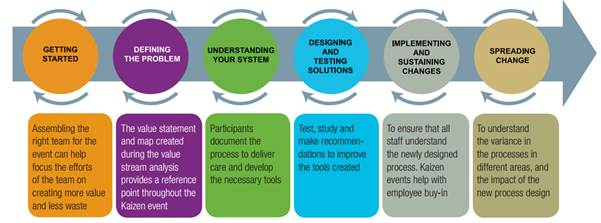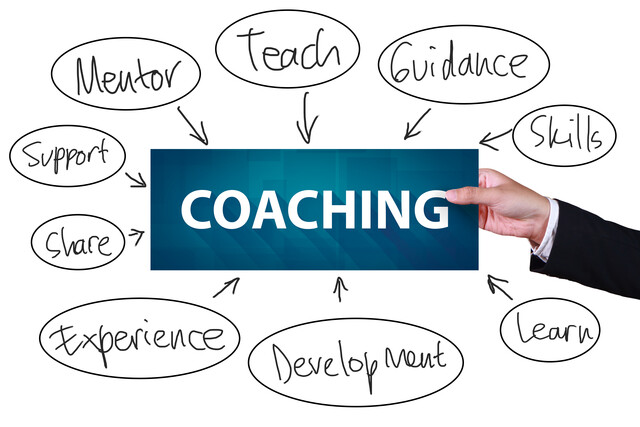Key Definitions
1. QI Framework � Quality Improvement framework for different services.
2. Intelligence Quotient (IQ) � Total score derived from different standardized tests established to assess human intelligence.
3. Paleo diet � A diet based on the kinds of food assumed to have been consumed by early humans.
4. Six sigma � A systematic system of eradicating defects in from a process.
5. Lean tool � A systematic system of eradicating waste in a process.
Defining a Kaizen Event
A Kaizen event is a well-structured team exercise that focuses on reducing waste and producing more value in a business process or activity. It is a knowledge creating event that is intended to promote efficient and effective production and delivery of a service or product. The two primary objectives of a kaizen event are to facilitate discovery of new products and processes � boost innovation � and to make sure best practices are followed throughout the organization. A kaizen event delivers quick solutions to a problem, but it requires support from everyone in the organization.
A Kaizen event is a team-oriented exercise because it:
-
Gathers together the owners of the process, managers, and operator in a specific area
-
Map outs the current processes
-
Analyzes the current processes and looks for way to improve them.
-
Seeks buy-in from all the people involved in the process under study to support the improvement.
Done well, a kaizen event result in immediate decrease in cost, improvements of core processes, and increased customer satisfaction. Although there are other process-improvement techniques that an organization can use; a Kaizen event is quite different in that:
-
The team meets for at least five days before submitting its final presentation.
-
The Kaizen event is action-oriented; adoption and recommendation of improvement strategies begins immediately. Note that other processes improvement techniques produce a list of recommendations.
-
As the event continues, team members use Six Sigma and Lean tools to identify value adding steps in the process, eradicate waste, simplify processes, and to reduce variation. All these translate to more value to the consumer.
There are important roles that need to be fulfilled before, during, as well as after a Kaizen event. Below is a table that shows the responsible parties, and the role they play at each stage:
|
Role |
Before the Event |
During the Event |
After the Event |
|
Senior manager |
The senior manager should be notified and sanction the event. |
Portray he is interested in the event by attending and speaking during its opening. |
Is updated frequently on the team's progress. He is updates the 30, 60, and 9 day progress checks. He resolves any issues that neither the sponsor nor the team leader can handle. Finally, he formally recognizes the entire team for a job well done. |
|
Sponsor |
Ensure that resources and people are available for the event. He approves the scope of the event. |
Hold meetings with the facilitators and team leader every day during the event |
Attend follow-up meetings |
|
Team leader |
Coordinates event's logistics to ensure success. |
Participate in the event as a team member |
Archives any document/material while tracking team history |
|
Team members |
Communicate with the team leader about purpose and logistic of the event |
Participate in the event as a team member |
Attends post-event meetings and follow-up assignments |
The aim of holding a Kaizen event is simply to identify wastes in your organization's processes and to eliminate. Usually, there are seven common wastes in a business process that kaizen events seek to eradicate:
|
Type of waste |
Description |
|
Over-production waste |
� Products being produced at a higher rate than required. � Causes may be poor scheduling, anticipating demand, poor production management, and lack of communication |
|
Excessive inventory waste |
� All goods produced in excess of what the client ordered � Inventory in the store is money tied-up, misuse of factory space, and waste of material |
|
Time delays waste |
� Human wait time or machine wait time |
|
Transportation waste |
� Unnecessary movement or handling of material, excessive movement of equipment, and numerous storage areas |
|
Processing waste |
� Errors that occur during processes � Caused by quality problems, machine error or human error |
|
Defect/rework/corrections waste |
� Duration took to inspect, rework, scrap or correct a product |
|
Excess motion waste |
� All unnecessary human reaching, walking, movement or bending during a process � Occurs when looking for material and tools that are far from workstations |
A successful Kaizen event usually goes through four steps:
-
Step one � The first step involves analyzing and mapping the current process in a certain area of the organization.
-
Step two � The second step involves identifying the issues as well as the opportunities for improvement.
-
Step three � The third step involves implementing changes to the process for improved workflow.
-
Step four � The last step involves evaluating the changes adopted and follow-up, with alterations as required.
For example, if a Kaizen event involves an assessment, it would cover everything from deciding elements that trigger the assessment, to designing the assessment tool, to regulating (standardizing) the follow-up processes. Participants in this event should be the people who really do the work because they are the ones who understand the current workflow and why and what changes are necessary.
You can use a Kaizen event at different stages of a QI Framework. This is shown in the diagram below:


Introducing Personal Kaizen Goals
As you might know, goals are not the answer. They are just a way to start moving and gain focus in a specific direction. Happiness, success, learning, and true growth come from the journey.
As a human being, you require goals to help you remain on track, design your life, and to give you a reason to wake up every day. The beauty of being a person is that you have the skill to get better at things via conscious endeavors, and this is very special.
The Power of Three
"The power of three" is a frequent term in Kaizen thinking and practice. It holds that, "You can easily realize 3 main tasks during a day, 3 main projects during a week, and 3 main goals during a month." Three is the ideal number when it comes to timelines, segmentation, and balance, and this explains why in most Kaizen journals, modules are classified into three categories. The 3 categories are:
-
Body � This is how you experience your physical world. You should care for it like a precious item. Your body allows you to move, create things, have fun, interact with others, and improve your skills.
-
Mind � This is how you experience your life or reality. You should change it to start thinking how you desire your life to be. You can change your thinking to live a steady, energetic, stress-free life.
-
Lifestyle � This is how you plan your limited time. You should plan your activities, relationships, possessions, finances, home and work life, and the time you give to others.
Through practicing the power of 3 as it relates to Kaizen, you can easily establish a body like a machine, a stainless steel mind, and the perfect lifestyle you desire. But it all starts with setting smart kaizen goals.
Setting Kaizen Goals
Step one
Before you start to think about what you will do tomorrow, you need to build your long-term vision. Open up the first page of your Kaizen journal, and label it "My Long-term Vision or My Future". Fill this page with the following information:
-
Where you want to be in five years
-
Where you want to be in three years
-
Where you want to be in one year
-
Where you want to be in six months
Under each of these headlines, write a few sentences about who you want to be, where you wish to live, how you want to feel, and what you want to have.
Here is an example to get you started.
|
My Future |
|
|
5 Years |
|
|
Running in quarterly marathons |
|
|
Own a large online organization |
|
|
Living in Colorado, near the mountains |
|
|
3 Years |
|
|
Happily married |
|
|
Own a BMW |
|
|
In peak physical condition |
|
|
1 Year |
|
|
Feeling happy and stress-free |
|
|
Financially stable |
|
|
In great shape |
|
|
6 months |
|
|
Finishing my education |
|
|
Taking a vacation |
|
|
Eating only healthy diets all the time |
|
You have probably heard about setting SMART objectives many times. They are very common in an organization environment because they work; your personal development goals should be smart too.
So, what do smart goals mean?
-
Specific � you should define exactly what you want to achieve.
-
Measurable � your goals should be quantifiable so that you can know if you are succeeding in attaining it or not.
-
Attainable � your goals should be reachable, not impossible to realize
-
Relevant � your goals should really matter to your organization or life
-
Timely � your goals should be time bound.
Step two
There are hundreds and hundreds of broad goals such as being healthier, being smarter, working less, etc that you can get behind. However, you should not try to attain all of them at once � just pick two or three that match your mind, lifestyle, body, and long-term vision. As you might have noticed, these goals are not definite and they can be improved constantly.
Note these goals on the second page of your Kaizen journal. Leave five or six lines in-between two broad goals, as you might need to add information below each of them. Split your goals into a few SMART objectives. Remember, your journal is designed to help you realize two or three powerful objectives following the power of 3. The goals should be should be exciting, challenging and within your reach. Here are a few examples:
-
To lose 15 pounds of fat in 3 months
-
To increase your IQ by 10 points in 3 months
-
To work 2 hours less each day in 3 months
The next step of goal creation is building an action plan. You cannot realize your goals without progress, movement, and action. To do this, just add the word "by" to the end of your goals and then bullet them. These are your daily plans and they may take a little research to discover. Spend a few hours online researching on "how to lose 15 pounds", "how to boost your IQ", and "how to work less every day". For every goal, take at most three steps that you can adopt on a daily basis, or work toward adopting on a regular basis.
Here are some examples, and how your final Kaizen SMART goals page should look:
|
SMART Goals |
|
|
Be Healthier |
|
|
To lose 15 pounds of fat in 3 months, by: |
|
|
� Exercising daily |
|
|
� Drinking only water |
|
|
� Eating only paleo diet 80 percent of the time |
|
|
Be Smarter |
|
|
To boost my IQ by 10 points in 3 months, by: |
|
|
� Taking a practice IQ test every week |
|
|
� Reading 30 minutes a day |
|
|
� Using a daily IQ training game app |
|
|
Work Less |
|
|
To work 2 hours less each day in 3 months, by: |
|
|
� Sending weekly report to my boss to prove I am more productive working fewer hours |
|
|
� Writing a to-do list every night so that I can have a start and stop plan every day |
|
|
� Cutting out Facebook, Twitter, and other social media during the day |
|
Step three
The third step involves being creative. Here, you need to set sub-goals that relate to your larger 3-month goal. These sub-goals will relate to what you want to achieve after one month,
For example, your first month might look like:
|
Monthly Kaizen SMART Goals |
|
|
Lose 10lbs |
By drinking only water |
|
Boost IQ by 3 points |
By playing one game a day and reading 10 pages |
|
Work one hour less |
By reducing social media hours during the day |
Step four
Occasionally, you might not realize your goals because you are not really passionate about the outcome. In order to make your objectives concrete, go back a page and write ten reasons why this is critical to you. Connect yourself to the outcome, become excited, and challenge your mind about your new journey.






























